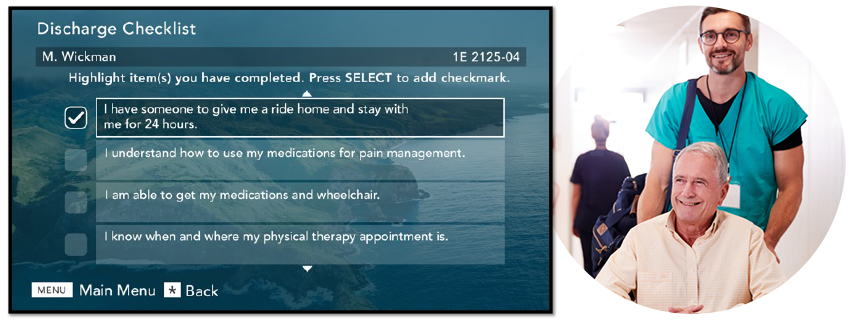February 28, 2023
. . .
In hospitals, discharge planning should begin as soon as a patient is admitted.
Effective discharge planning is important because it helps patients better heal and recover, ensures medications are prescribed and given correctly, and prepares patients and their families to take over care.
Why to use a patient discharge checklist
Empowering patients with post-discharge expectations can help them feel more prepared and confident in their care plan going forward.
One way to do this is with a discharge checklist that gives patients visibility and transparency into their care. With a simple list covering everything that needs to be done before leaving the hospital, you can better:
- Identify questions patients or their families may have
- Improve rounding and bedside communications
- Drive toward more efficient discharges and shorter lengths of stay
- Decrease the chances of readmission to the hospital

What to include in a discharge checklist
Consider the topics that would be most beneficial for your patient populations to assess their discharge readiness. Some significant areas to cover include:
- Education comprehension
- Medications
- Transportation
- Follow-up appointments
- Caregiver duties
- Dietary or activity restrictions
- Home care & therapy
- Medical equipment or supplies
- Post-discharge contacts
1. Put it on the TV
While in their room, patients are more likely to turn on the TV than open a folder of paperwork.
Incorporating a patient discharge checklist onto an interactive TV platform like SONIFI Health’s increases the likelihood patients will actually reference it and take action.
2. Make it available ASAP
The sooner patients can see what the expectations are, the sooner they can begin preparing themselves for discharge.
SONIFI Health’s interactive platform can automate discharge checklists based on the unit they’re in, making them accessible for patients to reference any time from the moment they’re admitted until they’re discharged.
3. Don’t reinvent the wheel
Look to your transition of care team for guidance and ideas to get a discharge checklist started.
If you have a checklist staff already use, try adapting it for patients.

4. Write it for patients
Use plain words that patients understand, and offer it in the languages most prevalent in your community.
Frame up the checklist in a way that puts patients in the driver’s seat of completing the tasks.
For example, use phrases like “I understand…” and “I have…” instead of “Do you…” or “I’ve been told…”.
This helps empower patients to take an active role, rather than passively waiting for your staff. See examples of customized discharge checklists in this free use case.
5. Consider demographics
You can tailor discharge checklists to be most impactful to different types of patients.
What resonates with a new mom will be different than a cancer patient, anxious parents, or a family caregiver responsible for a patient after their stay.
6. Include your nurses
Show your clinical staff where the discharge checklist is on the interactive system, and why it’s there.
Discuss what is (or should be) included on the checklist.
Create a voice command that makes it easy for nurses and patients to pull up the checklist on the TV.
Talk about the best times to review the checklist with patients, and incorporate it into your rounding practices.
7. Add a discharge channel
Complement the discharge checklist by creating a dedicated discharge channel on your interactive TV.
This custom channel can include instructions on how to access the discharge checklist, as well as community resources, support groups, reminders for patients and their families, and other details that further promote discharge readiness.
8. Consult with SONIFI Health
SONIFI Health’s teams of professionals are here to help guide hospitals in offering valuable patient engagement features with real impact.
Contact us to learn more about how we can help support your staff in improving discharge planning and patient outcomes.
Free use case:
Download discharge checklist examples here
. . .
Editor’s note: This article was originally published in 2018. It has been updated for freshness and comprehensiveness.
Stay connected
Get exclusive insights delivered to your inbox from our experts.
 By SONIFI Health
By SONIFI Health 